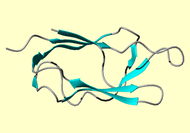
NMR Restraints Grid

 |
NMR Restraints Grid |
 |
Result table
| image | mrblock_id | pdb_id | cing | stage | program | type |
|
|
5139 |
1ghj |
cing | 1-original | MR format | comment |
*HEADER ACYLTRANSFERASE 16-JAN-96 1GHJ *TITLE SOLUTION STRUCTURE OF THE LIPOYL DOMAIN OF THE *TITLE 2 2-OXOGLUTARATE DEHYDROGENASE COMPLEX FROM AZOTOBACTER *TITLE 3 VINELAND II, NMR, MINIMIZED AVERAGE STRUCTURE *COMPND MOL_ID: 1; *COMPND 2 MOLECULE: E2, THE DIHYDROLIPOAMIDE SUCCINYLTRANSFERASE *COMPND 3 COMPONENT OF 2-OXOGLUTARATE DEHYDROGENASE COMPLEX; *COMPND 4 CHAIN: NULL; *COMPND 5 FRAGMENT: LIPOYL DOMAIN, RESIDUES 1-79; *COMPND 6 SYNONYM: E2; *COMPND 7 EC: 2.3.1.61; *COMPND 8 ENGINEERED: YES *SOURCE MOL_ID: 1; *SOURCE 2 ORGANISM_SCIENTIFIC: AZOTOBACTER VINELANDII; *SOURCE 3 EXPRESSION_SYSTEM: ESCHERICHIA COLI *KEYWDS GLYCOLYSIS, TRANSFERASE, ACYLTRANSFERASE, LIPOYL *EXPDTA NMR, MINIMIZED AVERAGE STRUCTURE *AUTHOR A.BERG,J.VERVOORT,A.DE KOK *REVDAT 1 11-JAN-97 1GHJ 0 This file contains the experimental data (NOE distance constraints, hydrogen bond distance constraints, and dihedral angle constraints) for the determination of the three-dimensional solution structure of the lipoyl domain of the dihydrolipoamide succinyltransferase component of the 2-oxoglutarate dehydrogenase complex from Azotobacter vinelandii. The method used to determine the solution structures of the lipoyl domain is the hybrid distance geometry-dynamical simulated annealing calculation strategy of Nilges et al. (1988) FEBS Lett. 229, 317-324. X-PLOR version 3.1 was used for the structure calculation. NOEs are grouped into strong, medium and weak categories, corresponding to upper-bound interproton distance constraints of 2.7, 3.3, and 5.0 A, respectively. An additional 0.5 A is added to the upper limits for distances involving methyl groups. In all cases, the lower-bound distance constraint is set to 1.8 A, the approximate sum of the van der Waals radii. NOEs which partially overlapped in the spectra were conservatively assigned an upper bound constraint of 5.0 A if their intensity grouping was ambiguous. The standard pseudoatom corrections (Wuthrich et al., 1983) are applied to methyl groups, degenerate diastereotopic hydrogen atoms, and diastereotopic hydrogen groups for which only one NOE was observed. For stereospecifically unassigned diastereotopic substituents for which NOEs to both hydrogens were observed, the DIANA treatment of diastereotopic hydrogens is used. In cases where both NOEs had an equal upper distance limit, no pseudoatom correction is applied. In cases where both NOEs have different upper distance limits, the upper distance limit of both NOEs is set equal to the higher limit of the two, and an extra 'DIANA' pseudoatom distance constraint is calculated and added to the constraint list, indicated by '!!' in the constraint list.
Contact the webmaster for help, if required. Tuesday, July 2, 2024 9:35:46 PM GMT (wattos1)